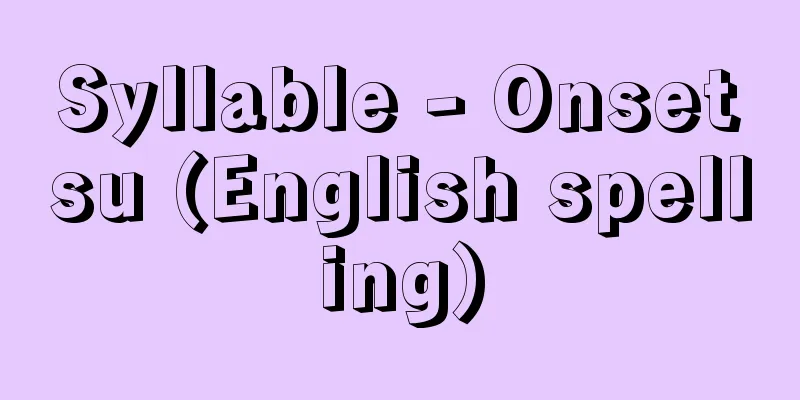Syllable - Onsetsu (English spelling)

|
A single sound or sequence of sounds that has no break within itself, but has breaks before and after it. Structurally, a syllable that ends with a consonant is called a closed syllable, and one that ends with a vowel is called an open syllable. The English word [dɔɡ] "dog" is an example of the former, and the Japanese word [me] "eye" is an example of the latter. Generally, a syllable is formed with a vowel at the center and a consonant before (after) it, but since the definition of a syllable is of a nature that ultimately requires a phonological perspective, its phonetic definition is difficult and varies among scholars. O. Jespersen determined the number of syllables based on the relative peaks of "hikoe," and Saussure defined the opening of the air passage as an internal plosive that tends to close and an external plosive that tends to open, and determined the break in the syllable as the transition from the internal plosive to the external plosive. In addition to "hiraki", M. Grammont introduced the viewpoint of increasing (gradual stress) and decreasing (gradual weak) tension of various organs during pronunciation, and considered the break in the syllable to be where the gradual weak changes to the gradual strong. He called syllables in which the gradual stress and the increase in "hiraki" and the gradual weak and the decrease in "hiraki" coincide "phonetic syllables", and syllables in which they do not coincide but are found in real languages "phonological syllables". Shiro Hattori distinguished between "phonological syllables", which have a certain structure in each language apart from moras, and "phonetic syllables" which occur in actual speech. "Okaasan" in the Tokyo dialect consists of five moras, with a break in the syllable [o|ka:|sa N ]/'o|ka˥a|sa N /, making it a phonetic trisyllable and a phonological trisyllable. On the other hand, /ha˥si/ “chopsticks” consists of two moras and is a phonetic two-syllable word, but it can also be pronounced as one phonetic syllable. In Japan, many people refer to this mora as a “syllable.” Source: Encyclopaedia Britannica Concise Encyclopedia About Encyclopaedia Britannica Concise Encyclopedia Information |
|
それ自身のなかには切れ目がなく,その前後に切れ目の認められる単音または単音連続をいう。構造上,子音で終るものを閉音節,母音で終るものを開音節という。英語の[dɔɡ]「犬」は前者,日本語の[me]「目」は後者の例。一般に,1つの母音を中心にその前 (後) に子音がついた形をなすが,しかし,音節の規定は,結局音韻論的観点が必要となってくる性質のものであるため,その音声学的定義は困難で,学者によりさまざまである。 O.イェスペルセンは「きこえ」の相対的頂点の数に音節の数を求め,ソシュールは呼気の通路の「ひらき」が閉鎖に向うものを内破音,開放に向うものを外破音とし,内破音から外破音に移るところに音節の切れ目を求めた。 M.グラモンは「ひらき」のほかに発音の際の諸器官の緊張の増加 (漸強音) ,減少 (漸弱音) の観点を持込み,漸弱音から漸強音へ移るところに音節の切れ目を求めるとともに,漸強性と「ひらき」の増大,漸弱性と「ひらき」の減少がそれぞれ一致する音節を「音声学的音節」,一致しないが現実の言語に見出される音節を「音韻論的音節」と呼んだ。服部四郎は,モーラとは別に各言語において一定の構造をもつ「音韻的音節」と,実際の発話に生じる「音声的音節」とを区別した。東京方言の「オカアサン」は5モーラから成り,[o|ka:|saN]/'o|ka˥a|saN/と音節が切れ,音声的3音節,音韻的3音節である。一方,/ha˥si/「箸」は2モーラから成り,音韻的2音節であるが,音声的1音節に発音されることもあるとする。なお,日本ではこのモーラをさして「音節」と呼ぶ人も多い。
出典 ブリタニカ国際大百科事典 小項目事典ブリタニカ国際大百科事典 小項目事典について 情報 |
>>: Speech recognition - onseininshiki (English)
Recommend
Eulalia quadrinervia (English spelling) Eulaliaquadrinervia
…[Tetsuo Koyama]. … *Some of the terminology expl...
Naevius, Gnaeus
Born around 270 BC. Rome? [Died] c. 201 BC. Roman ...
Kniphof, JH (English spelling) KniphofJH
...The results of the Edo period's acceptance...
Oniwayaki
During the Edo period, rulers and wealthy people ...
Siren (English spelling)
The English name of the witch Siren from Greek myt...
"European Continental Municipal Government"
In response to this, the Social Gospel movement f...
Belov (English spelling) Vasiliy Ivanovich Belov
1932‐ Russian author. Born into a farming family i...
Urazato Tokijiro - Urazato Tokijiro
The protagonist of Tsuruga Wakasa no Jō's Shin...
Limonium reticulatum (English name) Limonium reticulatum
… [Eiichi Asayama]. … *Some of the terminology th...
Fire-coloured beetle
…Including the cardinal beetle, many beetles in t...
Tally - Warifu
〘noun〙① An item made by writing characters or othe...
Riku Shusei
406‐477 A Taoist priest from the Liu Song dynasty ...
Eshuun
?-? A monk and renga poet of the Muromachi period...
Centripetal hypertrophy
… refers to the thickening and enlargement of the...
Black-faced Bunting (English spelling)
A passerine bird of the family Emberizidae (illust...









